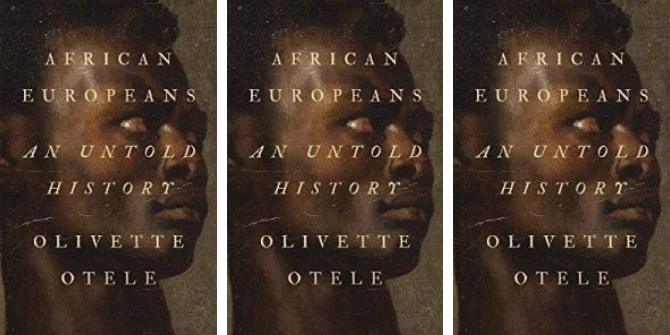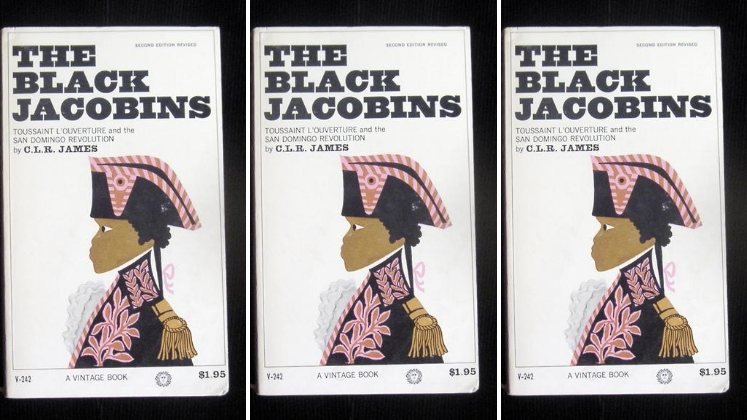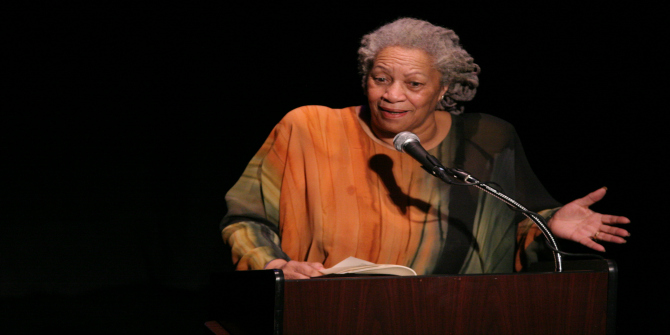In Black Enlightenment, Surya Parekh reconsiders the Enlightenment from the position of the Black subject, examining the works of writers such as Francis Williams, Ignatius Sancho and Phillis Wheatley against the period’s canonical thinkers, Immanuel Kant and David Hume. Parekh’s sensitive, disruptive analysis shows how early Black authors imagined and inscribed themselves as Enlightenment subjects, writes Lilly Markaki.
Black Enlightenment. Surya Parekh. Duke University Press. 2023.
 Surya Parekh’s Black Enlightenment invites us to reexamine the space opened up by the concept metaphor of the Enlightenment from the (im)possible position of the Black subject. Parekh opens the book with one of Ignatius Sancho’s letters, posthumously published in 1782. The move serves to announce something of the remedial intent of Parekh’s efforts with Black Enlightenment.
Surya Parekh’s Black Enlightenment invites us to reexamine the space opened up by the concept metaphor of the Enlightenment from the (im)possible position of the Black subject. Parekh opens the book with one of Ignatius Sancho’s letters, posthumously published in 1782. The move serves to announce something of the remedial intent of Parekh’s efforts with Black Enlightenment.
Black Enlightenment as a whole complicates attempts, by abolitionists, proslavery authors and canonical Enlightenment thinkers alike, to flatten the heterogeneity of the Black Enlightenment subject.
Sancho, an epistolary writer and “the only Black man known to have voted in the eighteenth century,” is seldom read, save, perhaps, for his correspondence with novelist Laurence Sterne. “The abolitionist frame,” as Parekh writes in the chapter dedicated to the author, “privileges the narration of [his] life over against a reading of his letters, setting the frame for our historical reception of eighteenth-century slave literature.” Combining literary and historical analysis with philosophical speculation, Parekh’s reading of Sancho troubles this frame, in the same way that Black Enlightenment as a whole complicates attempts, by abolitionists, proslavery authors and canonical Enlightenment thinkers alike, to flatten the heterogeneity of the Black Enlightenment subject.
Parekh performs leaps across space and time to offer us a sensitive picture of how early Black authors like Sancho, but also Francis Williams and Phillis Wheatley, imagined and, through writing, inscribed themselves as Enlightenment subjects
In the five chapters that make up the book, Parekh performs leaps across space and time to offer us a sensitive picture of how early Black authors like Sancho, but also Francis Williams and Phillis Wheatley, imagined and, through writing, inscribed themselves as Enlightenment subjects before the mainstreaming of abolition, only to be subsequently foreclosed by white European thinkers. Both necessary to Enlightenment thinking and actively preempted by the discourses of race to emerge therein, “the Black subject undoes the philosophical equilibrium of a [David] Hume or [Immanuel] Kant, disturbing their philosophical discourse” – a disturbance that, as Parekh notes in his long introduction to the book, has not gone unnoticed by scholars. Whereas the common strategy tends to resolve tension “either by dismissing these philosophers for racism or by trying to save them from such accusations,” Black Enlightenment takes a different approach, arguing that “we must learn to read” (and stay with) contradictions.
Parekh’s first task with the book is to show how [Hume and Kant] come to initiate an Enlightenment discourse of race that served to mask their anxiety over the spectre, raised by Williams, of Black political subjectivity
Reading the many attempts by the free Black Jamaican schoolmaster and poet Francis Williams to exercise political subjectivity – and Williams’ only extant poem, the ode to Haldane written in 1759 – alongside and against both Hume and Kant, Parekh’s first task with the book is to show how these thinkers come to initiate an Enlightenment discourse of race that served to mask their anxiety over the spectre, raised by Williams, of Black political subjectivity, by transforming the latter into “a foreclosable notion of Black genius.” The two chapters to emerge from this effort delicately unfold a complex intertextuality – involving consideration of the writings of Bernard Le Bovier de Fontenelle, Samuel Estwick, and Edward Long, among others – that is impossible to reproduce here. Titled “Black Enlightenment,” the first of these chapters introduces Williams’ entry into Enlightenment discourse in a perplexing footnote David Hume inserts into “Of National Characters,” while revising the essay in 1753. The note, which likens Williams to “a parrot, who speaks a few words plainly,” “rearranges and inverts the basic tenets of Hume’s philosophy. By way of the rhetoric of probability (‘I am apt to suspect’),” Parekh shows here, “an ontological distinction is proposed (‘the negroes, and in general all the other species of men . . . to be naturally inferior to the whites’). Black civilisation and intellectual labour are cast counterfactually as empirically absent (‘no ingenious manufactures amongst them, no arts, no sciences’) and thus ontologically impossible.” Producing a figure of Black interiority, “conjured only to be dispelled,” Hume’s note ignites a discourse – replete with distortions, emissions, erasures, and silences – that will consistently fail the Black subject.
Parekh avoids an easy dismissal of the text as blatantly racist. His argument is rather that Kant, and Enlightenment thinking more broadly, depend on the exclusion of the Black subject
Parekh’s second chapter, playfully titled “(Dis)Figuring Kant,” traces the spark of Hume’s footnote as it enters the body of Kant’s Observations on the Feeling of the Beautiful and Sublime, written in 1763. A curious, “flowery” treatise addressing questions of taste and morality, Observations finds the (otherwise) critical Kant appealing to Hume – whose footnote he cites and paraphrases – “to make the racist and reprehensible declaration that ‘Negroes’ are naturally inferior, grotesquely euphemizing the Middle Passage (‘hundreds of thousands of blacks who have been transported elsewhere’) and mocking the possibility of Black freedom.” Through a series of distortions and omissions, Kant posits an unbridgeable difference between what he describes as “two human kinds,” thus advancing a discourse of Black inferiority. “In a book concerned with education,” observes Parekh, “the question of education for freed slaves, a concern later of Reconstruction, is never raised.” Still, committed to staying with contradictions, Parekh avoids an easy dismissal of the text as blatantly racist. His argument is rather that Kant, and Enlightenment thinking more broadly, depend on the exclusion of the Black subject, hence the latter’s “dangerous necessity”: “As we confront the racism that Kant’s texts write,” observes Parekh, “we must notice how Kant flattens the figure of the Black subject (rather than stopping at arguments about whether or not Kant is racist). Kant’s effort at imagining a moral agent under capitalism needs this flattened Black subject […] We must therefore ask how the broadening of the feeling of the beautiful and sublime into a moral feeling about humanity depends on the persuasiveness of the representation of a Black subject who cannot rise.” As the abolitionist movement gained mainstream recognition in the 1780s, Black subjects began to rise everywhere, of course.
[Wheatley’s]poetry and correspondence figure a Black woman who courageously claims political subjectivity, even as the freedom her manumission (in 1773) promised her never truly arrives.
Chapter 3 stages a “confrontation” between Kant and, this time, Olaudah Equiano (a figure “cast as an exemplar of Black Enlightenment subjectivity”), against this backdrop of the mainstream of abolition. The chapter convincingly argues for a shift in the rhetoric of race, where the (now untenable) positing of a natural inferiority denying the existence of Black genius is substituted by “a simpler argument of natural idleness” or “natural Black ‘laziness.’” As with the previous chapters in the book, Parekh’s analysis here is at once deliciously close (from a reader’s perspective) and very painful (for the obvious reasons). Turning away from the “general racism” observed in “The Changing Rhetoric of Race,” Parekh’s final chapters platform two examples of Black genius: Ignatius Sancho and Phillis Wheatley, respectively. If the first of these chapters offers a lesson, as Parekh himself writes, in reading (“The implicit argument in this book is that you learn to read by attempting to learn to read texts that are written by subjects who are attempting to establish themselves in the writing”), the second and Parekh’s last, on “Phillis Wheatley’s Providence,” is a lesson in empathy. Wheatley’s history is uncertain (she “was likely born in 1753, kidnapped in 1760 or 1761, and purchased by John and Susanna Wheatley in 1761”); but her poetry and correspondence figure a Black woman who courageously claims political subjectivity, even as the freedom her manumission (in 1773) promised her never truly arrives. Wheatley, as Parekh notes here, “is a special case of the task that W. E. B. Du Bois asks of his readers, namely, to imagine the position of a slave who suddenly attains freedom.”
The Black subject is, or rather remains, but the imperfectly foreclosed horizon of Enlightenment thinking.
As Parekh turns to this figure, the tone of the book changes ever so slightly – it becomes softer. In line with the overall aims of Black Enlightenment, the chapter challenges us to imagine the Enlightenment from the impossible position of the Black subject “for whom the Middle Passage is a condition of entry.” But, more than any other chapter in the book, it “also articulates the limits of this staging—what Gayatri Chakravorty Spivak calls ‘transform[ing] … (im)-possibility … into the condition of its possibility’ through intellectual labor—so that it remains a continuing and open-ended effort.” Offering glimpses of “a rich subjectivity that cannot be fully determined by race or slavery,” Parekh’s Wheatley poetically demonstrates why the Black subject is, or rather remains, but the imperfectly foreclosed horizon of Enlightenment thinking.
Note: This review gives the views of the author, and not the position of the LSE Review of Books blog, or of the London School of Economics and Political Science. The LSE RB blog may receive a small commission if you choose to make a purchase through the above Amazon affiliate link. This is entirely independent of the coverage of the book on LSE Review of Books.
Main Image credit: Left to right, portrait of Olaudah Equiano via the British Library on Flickr; portrait of Phillis Wheatley via the Metropolitan Museum of Art; portrait of Ignatius Sancho via the Metropolitan Museum of Art, all Public Domain.








This article is really interesting